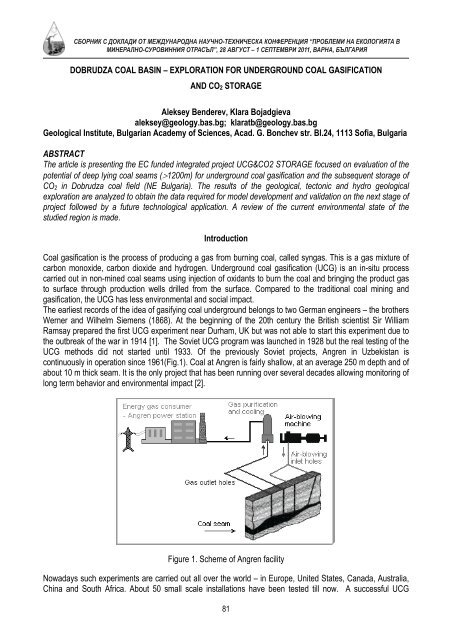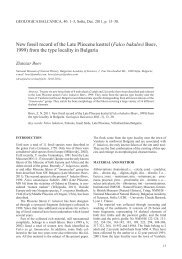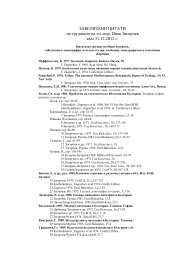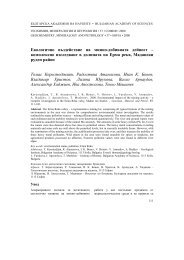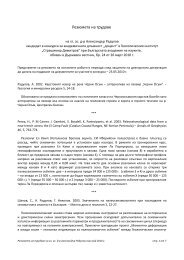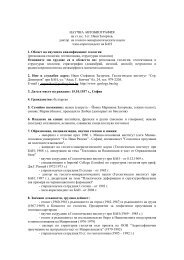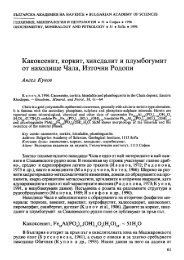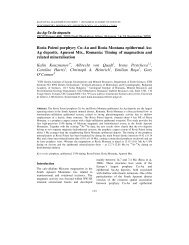EXPLORATION FOR UNDERGROUND COAL GASIFICATION AND ...
EXPLORATION FOR UNDERGROUND COAL GASIFICATION AND ...
EXPLORATION FOR UNDERGROUND COAL GASIFICATION AND ...
- No tags were found...
Create successful ePaper yourself
Turn your PDF publications into a flip-book with our unique Google optimized e-Paper software.
Сборник с доклади от Международна научно-техническа конференция “Проблеми на екологията вминерално-суровинния отрасъл”, 28 август – 1 септември 2011, Варна, БългарияDOBRUDZA <strong>COAL</strong> BASIN – <strong>EXPLORATION</strong> <strong>FOR</strong> <strong>UNDERGROUND</strong> <strong>COAL</strong> <strong>GASIFICATION</strong><strong>AND</strong> CO 2 STORAGEAleksey Benderev, Klara Bojadgievaaleksey@geology.bas.bg; klaratb@geology.bas.bgGeological Institute, Bulgarian Academy of Sciences, Acad. G. Bonchev str. Bl.24, 1113 Sofia, BulgariaABSTRACTThe article is presenting the EC funded integrated project UCG&CO2 STORAGE focused on evaluation of thepotential of deep lying coal seams (>1200m) for underground coal gasification and the subsequent storage ofCO 2 in Dobrudza coal field (NE Bulgaria). The results of the geological, tectonic and hydro geologicalexploration are analyzed to obtain the data required for model development and validation on the next stage ofproject followed by a future technological application. A review of the current environmental state of thestudied region is made.IntroductionCoal gasification is the process of producing a gas from burning coal, called syngas. This is a gas mixture ofcarbon monoxide, carbon dioxide and hydrogen. Underground coal gasification (UCG) is an in-situ processcarried out in non-mined coal seams using injection of oxidants to burn the coal and bringing the product gasto surface through production wells drilled from the surface. Compared to the traditional coal mining andgasification, the UCG has less environmental and social impact.The earliest records of the idea of gasifying coal underground belongs to two German engineers – the brothersWerner and Wilhelm Siemens (1868). At the beginning of the 20th century the British scientist Sir WilliamRamsay prepared the first UCG experiment near Durham, UK but was not able to start this experiment due tothe outbreak of the war in 1914 [1]. The Soviet UCG program was launched in 1928 but the real testing of theUCG methods did not started until 1933. Of the previously Soviet projects, Angren in Uzbekistan iscontinuously in operation since 1961(Fig.1). Coal at Angren is fairly shallow, at an average 250 m depth and ofabout 10 m thick seam. It is the only project that has been running over several decades allowing monitoring oflong term behavior and environmental impact [2].Figure 1. Scheme of Angren facilityNowadays such experiments are carried out all over the world – in Europe, United States, Canada, Australia,China and South Africa. About 50 small scale installations have been tested till now. A successful UCG81
Сборник с доклади от Международна научно-техническа конференция “Проблеми на екологията вминерално-суровинния отрасъл”, 28 август – 1 септември 2011, Варна, Българияexperiment needs to produce gas of a combustible quality from non-mined coal in a controlled manner thatallows the experiment to be reproduced. Gasification of shallow deposits, however, has a number ofdisadvantages, particularly regarding environmental issues. Contamination of groundwater by undesired byproductsof the process as well as the leaking of gas to the surface has been observed in several projects,particularly in the US and the former Soviet Union [1]. Recently, the attention of the scientific community hasbeen turned to deeper deposits, Fig.2. They are better shielded against potable groundwater horizons andmany of the deeper deposits would not be feasible to be mined by conventional underground mining.Major problems of UCG in deeper lying deposits comprise considerably higher drilling costs and establishmentof a sufficiently permeable connection between the gasification chamber and the production well [2].UCG has numerous economic and environmental benefits. Compared to above ground gasification, UCG ismuch cheaper, does not disturb land by mining, leaves ash in its natural location and allows an operating UCGplant to increase its syngas production at minimal capital cost. UCG seems to be the most suitable technologyto be used in conjunction with CO 2 storage, providing a reduction of greenhouse gas emissions compared tosurface exploitation.Figure 2. Distribution of UCG according to deposit’s depth[Best Practices in Underground Gasification by Burton, Friedman & Upadhye, 2006]Groundwater contamination and surface subsidence are possible environmental impacts of UCG. Every coalfield has specific geological structure and hydro geological conditions that should be examined in details inorder to define the possibility for UCG technology application.The first integrated project in Bulgaria focused on UCG and CO 2 storage is currently carried out in Dobrudzacoal deposit (NE Bulgaria). The full title of the project is: Study of Deep Underground Coal Gasification andthe Permanent Storage of CO 2 in the Affected Areas. It is financed by the EC Research Fund for Coal andSteel. The coordinator is Overgas Inc. company, Sofia, Bulgaria. Leading institutes from the UK, Portugal,Germany, Bulgaria and Greece participate in it. Duration of the project is 30 months beginning from July’2010.Dobrudza coal field has not been exploited till now because the coal is deposited at great depth (1200-1400)m, a thick Upper Jurassic- Lower Cretaceous aquifer (600-800) m is lying above it and the area is stronglytectonically disturbed. The project aims to assess the possibility of exploitation of the deep seated black coalby studying the geological and hydro geological conditions, modeling the process of coal combustion, syngasextraction and CO 2 storage.The expected outcomes of the project are:• Development of geological model for the central part of the Dobrudza Coal Deposit (DCD)82
Сборник с доклади от Международна научно-техническа конференция “Проблеми на екологията вминерално-суровинния отрасъл”, 28 август – 1 септември 2011, Варна, България• Development of geo-mechanical and cavity models for UCG spaces and CO 2 storage• Development of hydro-geological model of the DCD• Engineering, drilling and completion requirements for UCG & CO 2 storage• Environmental assessment of UCG - CO 2 storage• Economic assessment of UCG and CO 2 storage. Review of regulatory requirements and assessment ofoverall feasibility of processGeological backgroundGeological and geophysical explorations in the basin were performed during a long period between 1960 and1986 and the lithologcal structures, genesis and tectonic development of the basin have been studied. Theseresults are summarized in a monograph compiled by a group of authors [4]. A geothermal study has beenconducted using geophysical data taken from a large number (over 100) of deep wells drilled along a set atspacing of 1000 m and at less than 500 m in the center of the basin. Temperature data recorded underunsteady thermal regime are available for 83 wells and under recovered thermal regime – for 37 wells [5].Dobrudza coal deposit is the deepest in the country situated in NE Bulgaria at about 4-5 km from the Blacksea coast. It was discovered in 1962 during oil and gas exploration. The coal deposit is a part of Varnadepression superimposed on the Moesian plate. It is situated in Vranino horst which is a part of vast Paleozoicsubsidence, built of slightly folded Carboniferous layers berried under the Mesozoic sediments. The area ofthe horst is about 420 km 2 . It is bounded by faults and the blocks bordered the horst are lowered along thefaults by more than 1000m. Fig.3. The horst is mostly faulted in the area of coal deposit.Figure 3. Location of Vranino horst and major faults in the studied areaThe coal layers are found in Upper Carboniferous which has a total thickness of 1000 m. They are covered byPermian to Quaternary rocks. The prevailing slopes of Carboniferous layers are 10-15 o . They are faulted byalmost vertical tectonic fractures in sub- meridian direction and amplitude of 100m. Rocks of Permian toMiddle Jurassic age varying in thickness and permeability are deposited between the Carboniferous and theaquifer of highest water capacity - Upper Jurassic – Lower Cretaceous. Above the most shallow part of thedeposit are found 20-50 m thick Middle Jurassic water permeable sediments while in its northern and easternpart the sediments are of Perm-Triassic and Lower Jurassic age, their thickness reaches several hundredmeters and are of low permeability [6].83
Сборник с доклади от Международна научно-техническа конференция “Проблеми на екологията вминерално-суровинния отрасъл”, 28 август – 1 септември 2011, Варна, БългарияThis complex tectonic and geological structure could create paths for water movement and gas migrationduring the process of coal exploitation. It would be a subject to modeling under different assumptions forexisting water conduits.Dobrudza coal deposit is one of the most perspective areas in Bulgaria for exploitation in terms of coal quality.Coal seams with production capacity are located in Makedonka, Krupen and Gurkovo formations, Table1, [4,6]. These formations contain 27 coal seams in total of them 16 are with production capacity and total thicknessof 31,5 m (seems with thickness above 0,8 m are considered productive).The coal quality depends on the rate of coalification and chemical composition. The rate of coalificationobserved in the coal seams is changing in vertical and horizontal direction and ranges over a large interval –from sub-bituminous A to bituminous low volatile matter.Coal formationsFormationthickness, mNumber of coal seams, (incl.exploited),mGurkovo 250 11 (3) 11,2 ( 7,0)Krupen 60 4 (4) 7,25 (6,25)Makedonka 180 12 (9) 16,9 (15,8)Mogilishte 530 41 (1) 21,5 (2,5)Table 1Total average coal seam thickness(incl. exploited) mThe main organic coal components (Table 2) and the caloricity values, varying in the interval (31,7 – 34.0)MJ/kg define the good prospects for coal exploitation.Table 2Group/ Formation Vitrinite Exinite Internite MineralimpuritiesGurkovo 48 15 25 12Krupen 53 14 19 14Makedonka 52 14 20 14Hydrogeological backgroundThe regional distribution of aquifers and the existing connection between them are one of the main subjects ofthis study. The hydro geological factor is of crucial significance in the discussed region due to the existence ofdeep seated Upper Jurassic- Lower Cretaceous aquifer used for water supply in the region. For this reason nocontamination related to coal exploitation is admissible.The Dobrudza coal deposit is a part of Varna artesian basin. Its recharge zone is at about 80 km to the west inthe region of North Bulgarian Uplift and the drainage zone is in the Black sea aquatory. The main aquifersdiscovered in the basin are of Neogene, Paleogene and Upper Jurassic- Lower Cretaceous age. They areregionally traced and of high water capacity, while the aquifers of Dogger, Triassic and Carboniferous are ofsmaller water capacity.Upper Jurassic - Lower Cretaceous aquifer is of highest thickness and water capacity in the region. Accordingto the published data [4] its top lies at a depth from 300 to 700 m in the region of Dobrudza deposit. Its totalthickness is about 600-800m. The reservoir is mainly built of limestone and dolomite a is a natural drainagezone of the existing aquifers.The transmissivity coefficient for different aquifers discovered in the region varies in a wide interval – from verylow (less than 0,08 m 2 /24h in Carboniferous) to about 15 000 m 2 /24h – Neogene and Upper Jurassic- LowerCretaceous, Fig.4.The analysis of the existing hydrogeological data resulted in defining of four hydro-stratigraphic units as a basefor developing the regional model - Upper Jurassic- Lower Cretaceous aquifer, Perm-Triassic aquitard,Carboniferous aquifer and Devonian aquifer.84
Сборник с доклади от Международна научно-техническа конференция “Проблеми на екологията вминерално-суровинния отрасъл”, 28 август – 1 септември 2011, Варна, БългарияSarmatian part of NeogeneLower part of NeogeneOligoceneEoceneUpper Jurassic- Lower CretaceousDoggerCarboniferous0,00001 0,001 0,1 10 1000 100000Transmisivity, m/dFigure 4. Transmissivity variation in different aquifersThe dominant role of Upper Jurassic- Lower Cretaceous aquifer in the hydrodynamic regime of the region isconfirmed also by the hydro chemical analysis. The highest value for the total dissolved solids is calculated forthe Carboniferous while the lowest one - belongs to the karst aquifers - Upper Jurassic-Lower Cretaceousaquifer and Neogene (Sarmatian part), where water movement is very intensive, Fig.5a. Although UpperJurassic-Lower Cretaceous aquifer is deep seated it has a similar chemical composition with the shallowerNeogene aquifers, Fig.5b. The other aquifers are characterized by a stagnant water regime and contrastchemical composition. Carboniferous and Upper Jurassic-Lower Cretaceous aquifer are probably notconnected as they differ a lot in their chemical composition.100a)TDS, mg/l1010,1b)100%90%80%70%60%50%40%30%20%10%0%CarboniferousDoggerUpperJurassic-LowerCretaceousEoceneOligoceneNeogeneHCO3 SO4 Cl Ca Mg Na+KFigure 5. Results from hydrochemical analysis, a) TDS variation b) chemical composition85
Сборник с доклади от Международна научно-техническа конференция “Проблеми на екологията вминерално-суровинния отрасъл”, 28 август – 1 септември 2011, Варна, Българияfacilities. The close location of protected areas and lakes will require strict quality control of surface andunderground waters, discharging in them.Geological environment and ground water are mostly exposed to the impact of underground coal gasificationand CO2 storage. This assessment would be one of the project outcomes.Conclusions- The collected and analyzed geological and hydro geological information outlined the main factors thatshould be considered in modeling the processes of underground coal gasification and CO 2 storage inDobrudza coal deposit- The high caloricity coal values define good prospects for exploitation.- The accumulated experience in deep coal gasification in the recent years is a good base for promotingthe technology in the country.- Underground coal gasification technology will provide minimal land disturbance practically nocontamination of the surface water.References1. Klimenko, A. Early Ideas in Underground Coal Gasification and Their Evolution, Energies 2009, 2, 456-476;doi:10.3390/en202004562.2. Schlüter R., Kempka,T., Nakaten,N. Review of operational UCG-CO2 injection scenarios and the optionsfor CO 2 storage. UCG_CO2 storage project, 2011.3. Blinderman, M.S.; Anderson, B. Underground coal gasification for power generation: Efficiency and CO2-emissions. Proc. 12th International Conference on Coal Science, Cairns, Australia, November 2–6, 2003;Paper No. 13C1.4. Hristov ,Z.(Chief editor), Geology of Dobrudza coal basin, Technika, S, 1988 (in Bulgarian), pp.170.5. Bojadgieva, K., S.Gasharov, S.Veselinov.1998.Geothermal Study of the Hydrogeological Regime in theRegion of the Dobrudja Coal Deposit (NE Bulgaria)-Bulgaeian Geophysical Journal, XXIV, 3-4,127-136.6. Kamenov,B., Z.Nikolov, E.Stefanova 1984. Coal basins and deposits in Bulgaria, In: Coal basins and fieldsof the countries members of UMIA and Jugoslavia. Ed. UMIA, Moskow, 1984, p.107-161.(in Russian)87


